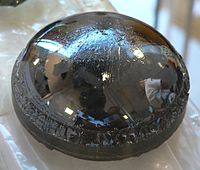
Photo from wikipedia
A mild in situ method was developed to construct an iron doped rutile TiO2 photocatalyst like cauliflower for degradation synthetic textile dye-methyl orange. The synthesized photocatalysts presented distinguished photocatalytic activity.… Click to show full abstract
A mild in situ method was developed to construct an iron doped rutile TiO2 photocatalyst like cauliflower for degradation synthetic textile dye-methyl orange. The synthesized photocatalysts presented distinguished photocatalytic activity. At the optimal Fe concentration (0.5%), the decomposition rate of methyl orange (MO) was about 90% under 40 min of ultraviolet (UV) light irradiation. Whereas, to our knowledge, only 70% of the decomposition rate of MO was achieved by commercial photocatalyst P25 under the similar reaction condition. Additionally, the rutile preparation temperature did not exceed 100 °C, which was much lower than the traditional preparation calcination temperature (e.g., 600 °C). The specific surface area of Fe doped catalysts was bigger than that of the control sample and the catalyst characterization indicated that the doped iron was incorporated into the rutile TiO2 lattice and resulted in the lattice disorder. The lattice disorder would have generated surface defects in the crystal structure, which was in favor of the photocatalytic reaction. The UV-Vis diffuse refection characterization and Density Functional Theory (DFT) calculation suggested that doping a small amount of Fe into the lattice of rutile would lead to a narrower band gap and the formation of a doping energy level between conduction and valence bands of TiO2. This further increased the degradation efficiency of synthetic textile dyes in wastewaters. Our study has provided a relatively easy operation for synthesis Fe doped rutile TiO2, which is a benefit to decrease the cost in wastewater treatment process.
Journal Title: Catalysts
Year Published: 2019
Link to full text (if available)
Share on Social Media: Sign Up to like & get
recommendations!